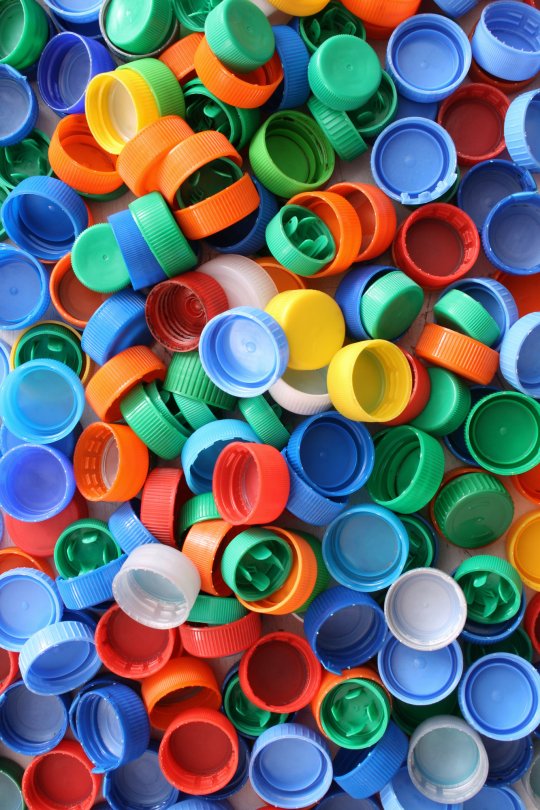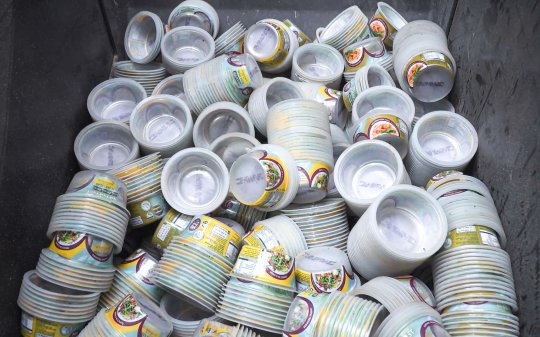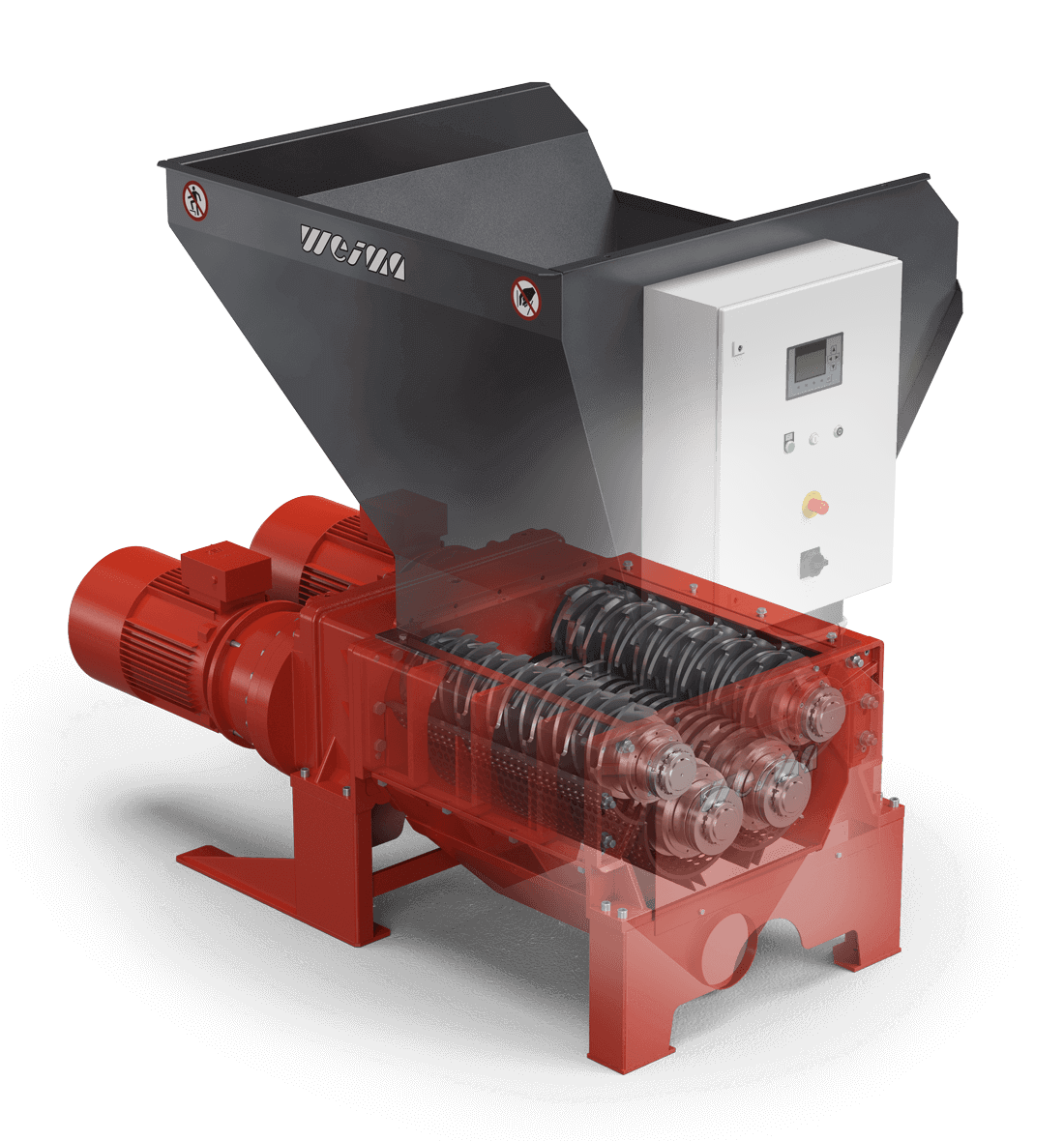
Shredding and recycling rigid plastics
Information on the processing of rigid plastic post-consumer and post-industrial waste and packaging
Rigid plastics are so-called non-packaging plastics produced through various thermoforming processes. They include products such as buckets, watering cans, flower pots, pasta strainers, garden furniture and laundry baskets, which are used in private households. The industrial sector also uses hard plastics such as plastic pallets, trash containers, waste garbage cans and pipes.
All too often, discarded plastics mistakenly end up in the residual waste garbage can, in the packaging recycling bin (so-called "Gelber Sack") or in bulky waste. It is not uncommon for them to be incinerated to generate energy. In this way, they lose their recycling potential. The better solution is the recycling of post-consumer and industrial rigid plastics. The first step towards sustainable processing is shredding with WEIMA shredders to produce high-quality recyclate – the basis for all products made from recycled plastics.
What are rigid plastics?
In German-speaking countries, rigid plastic waste is understood to mean in particular larger, voluminous plastic residues that are not disposed of in the yellow bag. These include plastic toys, sandboxes, canisters, bowls and laundry tubs. They can usually be dropped off free of charge at recycling and reclamation centers.
Their sturdy and usually rigid shape makes them usable for longer while being comparatively lightweight and easy to manufacture. The biggest advantage, however, is certainly their recyclability, provided used plastics are disposed of correctly.
In the USA, rigid plastics also include many types of rigid packaging, such as cups, trays and boxes used to transport food, but more on this later.

Post-consumer rigid plastic waste
What material are rigid plastics made of?
- PE (Polyethylene)
- HDPE (High-density Polyethylene)
- PP (Polypropylene)
- PS (Polystyrene)
- PET (Polyethylene terephthalat)
- PA (Polyamide)
- PC (Polycarbonate)
- ABS (Acrylonitrile butadiene styrene copolymer)
- PVC (Polyvinyl chloride)
Rigid plastics can be produced from thermoplastics using various processes: Toys and car parts, for example, are manufactured by injection molding. Bottles and containers are produced by blow molding. And large hollow bodies such as industrial drums or water storage tanks are produced by rotational melting.
About 65% of the rigid plastics fraction consists of polyolefins such as PP, PE and HDPE.
Source: Plastics Cluser
Which materials and products do not belong to classic hard plastic recycling?
At many collection points, such as recycling centers, some plastic types and products are not accepted that are unusable for classic rigid plastic recycling. These include cables and cable ducts, films, flooring, automotive parts, nets and hoses, but also small-volume packaging such as yogurt cups or PET bottles. Materials such as PVC, PA, ABS, PET, GRP and PC are also frequently rejected.
If the above-mentioned materials accumulate in industry as production waste, they can of course still be recycled on site. For this purpose, we recommend so-called in-house recycling. We also offer the appropriate shredder for this as part of a processing line.

Plastic bottle lids and caps
Rigid Packaging
In contrast to flexible packaging (e.g. tubes, bags, films), packaging made of rigid plastic offers better protection for the contents. In the era of to go, take away and delivery services, rigid packaging serves as spill protection for liquid contents. Fragile items are also often packaged in rigids.
In the United States, people do not separate small packaging (yogurt cups, plastic bottles, milk and juice canisters, caps and lids) from the typical rigid plastics known in Germany. There, all recyclable plastic waste from the consumer goods sector is collected together and recycled, provided it has been disposed of in recycling garbage cans.
Awareness of the circular economy is steadily increasing. In 2016, for example, U.S. residents recycled more than 660,000 tons of rigid plastics (<a href="https://www.recyclingtoday.com/article/2016-recycling-rates-film-and-rigid-plastics/"Source).
The variety of rigid plastics
- Water barrels, canisters, buckets
- Vats, fruit crates, folding baskets
- Composters, garden furniture, watering cans
- Sandbox toys, bobbycars, clothes hangers
- Plastic pallets, containers, IBCs
- Big boxes, paloxes, window frames
- Suitcases, child seats
These and other products reflect the forms and variety of rigid plastics in industry as well as in private households.
Challenges in rigid plastics recycling
Plastic waste is often a diverse mixture of different polymers. They have to be separated into fractions. After use and due to joint collection, used plastics are often heavily soiled or contaminated, for example with soil and sand. It is not uncommon for products to also contain embedded metal such as aluminum, copper or iron.
A classic example is the toy car with rigid axles made of iron, which must be removed from the plastic during the recycling process.

Plastic toy car
Did you know?
Throughout Germany, nearly 3 million tons of plastic are recycled each year. From this, about 1.9 million tons of recyclate can be produced after the removal of impurities and color sorting.
Source: German Federal Ministry for the Environment, Nature Conservation and Nuclear Safety
Industry example: WEIMA W5.18 single-shaft shredder with hydraulic drive shreds trash cans
Customer reference: kayaks on the recycling wave
In Exeter, UK, the company Devon Contract Waste recycles a wide variety of hard plastics. These include not-so-common items such as fuel tanks, kayaks and road cones. Central components of the two-stage recycling plant are a WEIMA WLK 1500 single-shaft shredder and a WSM granulator / granulator.
Inquire about a rigid plastics shredder today
Request a quote
Recycle rigid plastics instead of incinerating or landfilling
Plastic waste makes up the largest share of waste streams in Germany each year. While landfilling or incineration in waste incineration plants used to be without alternative, many plastics can now be easily recycled. In addition, legislators worldwide are continuously restricting landfilling. The aim of the circular economy is to keep plastics in circulation and recycle them as often as possible. The use of fossil raw materials can thus be significantly reduced. Consequently, the need for sustainable recycling plants is increasing – also for the processing of rigid plastics.

Rigid plastic household waste collection
Did you know?
In Germany, about 46 percent of the plastic waste generated is recycled, while the rest is landfilled or incinerated for energy recovery.
Source: German Federal Ministry for the Environment, Nature Conservation and Nuclear Safety
WEIMA W5.18 single-shaft shredder shreds rigid plastic caps for subsequent recycling
How does the shredding of hard plastics work?
Rigid plastics can be fed into the hopper of the WEIMA single-shaft shredder in bulk or in bales by conveyor belt, crane, wheel loader or forklift truck without manual preparation. The plastic is pressed against the rotating rotor by the hydraulic pusher and uniformly shredded to a homogeneous particle size. The screen size used, usually 40 - 80 mm for hard plastics, defines the size of the material to be ground. The material is usually transported by conveyor belt to the next process step, washing, drying, or extrusion.
Shredding of various post-consumer hard plastics with a WEIMA shredder
What happens to the shredded rigid plastic?
The complex processing includes not only a robust shredder but also appropriate separation technology such as metal separators or metal detection. After shredding, the plastic flakes are washed in a washing plant and separated into the individual fractions in a sink-float process. These can then be recycled into regranulate in a recycling extruder. The regranulate or reclaim can be used in the manufacture of plastic products such as trash cans, buckets, pallets or containers.

Plastic granulate from rigid garbage cans
Applications for the sustainable disposal of hard plastics from industry and private households
Rigid plastics in the plastics cycle
Mechanical recycling
After pipes have been collected, sorted and washed, they are reduced to homogeneous regrind with the aid of shredders. From this, high-quality regranulate can be produced using extrusion equipment – the basis for the production of new plastic pipes as recyclate within the in-house recycling process.
Chemical recycling
In contrast to mechanical recycling, chemical reprocessing attempts to return products made from plastics to their chemical raw materials in order to produce new plastics. However, the separated fractions are not completely pure, which can lead to problems with precise formulations.
Heavy duty machine design
WEIMA shredders for processing highly abrasive materials can be protected with various options to reduce wear and thus downtime and maintenance costs. The heavy wall thickness of the machine frame makes WEIMA shredders particularly robust. The rotor can be reinforced with Vautid, the screen with Creusabro. To protect the cutting knives against the impact of foreign objects, large knives with edge lengths of up to 130 mm x 130 mm can be selected. If the number of knives is small. Vautid can also protect knife holders.
To avoid increased wear of the rotor face plates, we recommend the installation of replaceable Creusabro wear plates on both sides. The cutting chamber can also be reinforced and optionally lined with exchangeable Creusabro plates. Wear protection does not stop at the screen, which defines the material size. For particularly high wear, we offer a screen reinforced with Creusabro with a wall thickness of approx. 20 mm.
What is Creusabro?
Creusabro is a high performance wear resistant steel. Compared to low alloy wear resistant steels, Creusabro has a higher heat resistance. WEIMA uses Creusabro with a hardness of 58 HRC.
What is Vautid?
Vautid is a buildup welding material that can be applied to components as a welding alloy. In WEIMA shredders, Vautid with 62 HRC is applied.
What is Hardox?
Hardox it an abrasion resistant steel and is mainly used as wear plate with a hardness of up to 600 HBW. Depending on the requirements, different degrees of hardness can be applied.
WLK series: highly productive plastic shredders
Machines of the WLK series are specially designed for plastic applications of all kinds. They are highly robust and durable. S5 and S7 shredders are equipped with an extra-large rotor, making the shredders very flexible to be used for heavy-duty jobs.
Shredding of discarded plastic beverage crates with a WEIMA WLK 1500 single-shaft shredder
W5 series: Maintenance-friendly all-rounders with swing ram
With working widths of 1,400 mm, 1,800 mm or 2,200 mm, the W5 series takes on a wide variety of materials. The inspection flap and the lift-up screen basket make the single-shaft shredder particularly easy to maintain. Thanks to the wide conveyor belt cutout, large quantities of shredded material can be transported away quickly and cleanly.

WEIMA W5 shredder interior view
Best suited for hard plastics – the V rotor
The V rotor, specially developed by WEIMA, can be used universally and is made of solid material. Its aggressive material feed guarantees high throughput with low power requirements. Hardened steel cutting knives and adjustable counter-knives ensure the optimum cutting geometry, which can be precisely adapted to the material requirements. The result: homogeneous shredding results, high throughput rates, low energy consumption, resistance to foreign material, and low wear.

WEIMA V-rotor shreds HDPE pipes
PreCut series: For extreme throughput requirements
The PreCut 2000-3000 series is characterized by extremely high throughput rates. PreCut machines are often used as pre-shredders in multi-stage processing plants, but are also suitable as stand-alone solutions. The massive PreCut rotor is particularly resistant to foreign matter thanks to Vautid wear protection. Reinforced side walls make the shredder's frame extremely solid.

WEIMA PreCut single-shaft shredder
Recycling is for the bin
The Swedish company Veolia Recycling Plastics Sweden AB recycles garbage cans and other HDPE plastic waste from production using a WEIMA PowerLine 2500 shredder and downstream washing system.
PowerLine series: Sharp cuts
The machines of the PowerLine series are universally applicable. Variable equipment and sizes allow an exact adaptation to your special requirements. The counter knives are user-friendly adjustable from the outside and protected by an additional cover plate.
ZM four-shaft shredder: For clean production waste
ZM series machines are ideal for shredding long, bulky and voluminous materials. Their large feed hopper offers sufficient space and can be conveniently filled by hand, conveyor belt or forklift. ZM shredders have a cutting unit with two clearing shafts as well as two cutting shafts, which are characterized by their aggressive material intake. Compared to single-shaft shredders, four-shaft shredders cut at a slower speed and do not have a material pusher. The noise level is correspondingly lower, and the throughput is consistently high. A screen that can be mounted below the cutting unit defines the desired particle size of the output material.
WEIMA ZM 50 four-shaft shredder shreds 220 liter plastic drums
Select your preferred drive:
High-Torque drive
The high-torque, multi-pole synchronous motor from Baumüller is produced in Germany and is characterized by its insensitivity to foreign bodies. Without gears, the drive resists shocks and vibrations and thus has a particularly long service life – even when shredding challenging material streams.

Acionamento de alto binário da Baumüller
Hydraulic drive
Hydraulic drives from Hägglunds / Bosch Rexroth have no gearbox and are therefore particularly insensitive to many contaminants. Speed and torque can be adjusted without current peaks. The robust drive provides high torque at low kW power. The speed can be variably adjusted by means of a regulating pump.
Only at WEIMA
Heavy-duty machine design
for long service life
Large feed hopper
for easy feeding of particularly large hard plastic bales and loose rigid plastics
Easy maintenance
for minimized downtimes
Many drive options
for maximum throughput
Applied know-how
for minimized operating costs
Fast service
for highest customer satisfaction
All from one source:
Machines, conveyor technology, metal detection, support, spare and wear parts for customized solutions

WKS shredder with inspection flap
See for yourself
The WEIMA showroom is equipped with shredding and briquetting machines of all sizes and technologies. This enables us to simulate your application as realistically as possible. You have the possibility to send us your material or visit us directly in Ilsfeld. From our gallery you have the best view directly into the cutting chamber. So you can observe the shredding process live.
Request an appointment now
Alternatively you can send us material for testing.
Click here for the form.























































